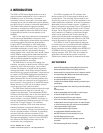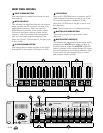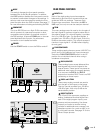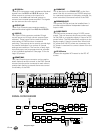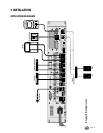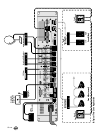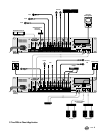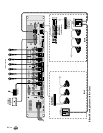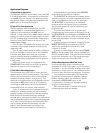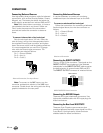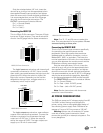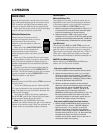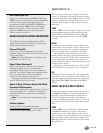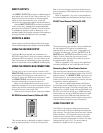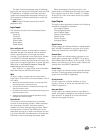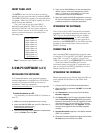
DX8 – 11
Application Diagrams
A: Typical Stereo Application
This diagram depicts a simple setup, using the DX8
in a stereo application. A microphone is connected
to the MIC input on channel 1 for paging purposes,
and several program sources are connected to the
LINE inputs on channels 3 through 8.
B: Typical Two-Zone Application
This configuration demonstrates how the DX8
might be used in a restaurant/bar application. A
paging mic is connected to the MIC input on
channel 1. Notice the priority enable switch near the
paging mic, which causes the other inputs to either
turn off or reduce their volume levels, depending on
how the Force-On/Off function is set up in the
Audio Input window.
Zone A uses a 70V distribution system for broad
coverage using multiple speakers throughout the
restaurant area.
Zone B uses a stereo power amplifier configured
for mono operation to power two or four speakers
in the bar area. Each zone has a pair of remote
controls, allowing access to predefined functions
such as level control and program source selection
in each zone.
A 24V DC power supply is connected to the
POWER INPUT
connector on the DX8, for backup
operation in case of an AC power failure.
C: Two DX8s In Church Application
This illustrates using two DX8s to meet the many
requirements in this church application. The primary
DX8 is used to connect the various microphones
located at the pulpit, lecturn, and choir loft. Two
additional microphones from the Fellowship Hall are
connected to MIC inputs 5 and 6. A CD player is
connected to LINE inputs 7 and 8 for playback of
prerecorded music for soloists when required.
A pair of remote controls is located at the pulpit,
primarily for selecting presets for various events
such as Sunday morning service, Monday evening
Bible study, and Saturday afternoon weddings.
Another pair of remotes is located in the Fellowship
Hall to control the level for the microphones (assigned
to a Fader B Control Group) in the Fellowship Hall,
and to choose whether the Sanctuary mics are
heard in the Fellowship Hall and whether the
Fellowship Hall mics are heard in the Sanctuary.
A cassette deck is connected to the
RECORD
output jacks for recording the service.
The
A OUTPUT is
connected to a stereo power
amplifier configured for mono operation that drives
a pair of loudspeakers that cover the sanctuary.
The
B OUTPUT
is connected to an additional
power amplifier configured for mono operation
that provides power for a pair of speakers in the
Fellowship Hall.
The secondary DX8 is used to connect the
microphones and instruments for the band. The
A
and
B OUTPUTS
are connected to the
BUS A
and
B
LINE
inputs on the primary DX8, where the signal is
mixed with the program sources connected to the
primary DX8.
A digital multitrack recorder is connected to the
DIRECT OUTPUTS
on the secondary DX8 for
tracking the vocals and instruments for later
mixdown to 2-track.
A laptop is connected to the front panel
COMM
PORT
on the secondary DX8, using a standard 9-pin
RS-232 computer cable. This gives the band remote
control over the entire mix of the instruments and
vocals connected to the secondary DX8.
D: Board Room Application With Two-Zones
In this configuration, eight microphones are
connected to a DX8. The podium mic is connected
to channel 1, and has a priority enable switch near it
connected to a logic input for the moderator to use
to mute or duck the other microphones, if required.
Two zones are covered using 70V distribution.
Zone B can be partitioned off, and has a second
DX8 for selecting either the board room source
(connected to
BUS B LINE
input), or the
microphones in Zone B (for a separate meeting
going on simultaneously).
Each zone has a pair of remote controls for
configuring the system as needed.



